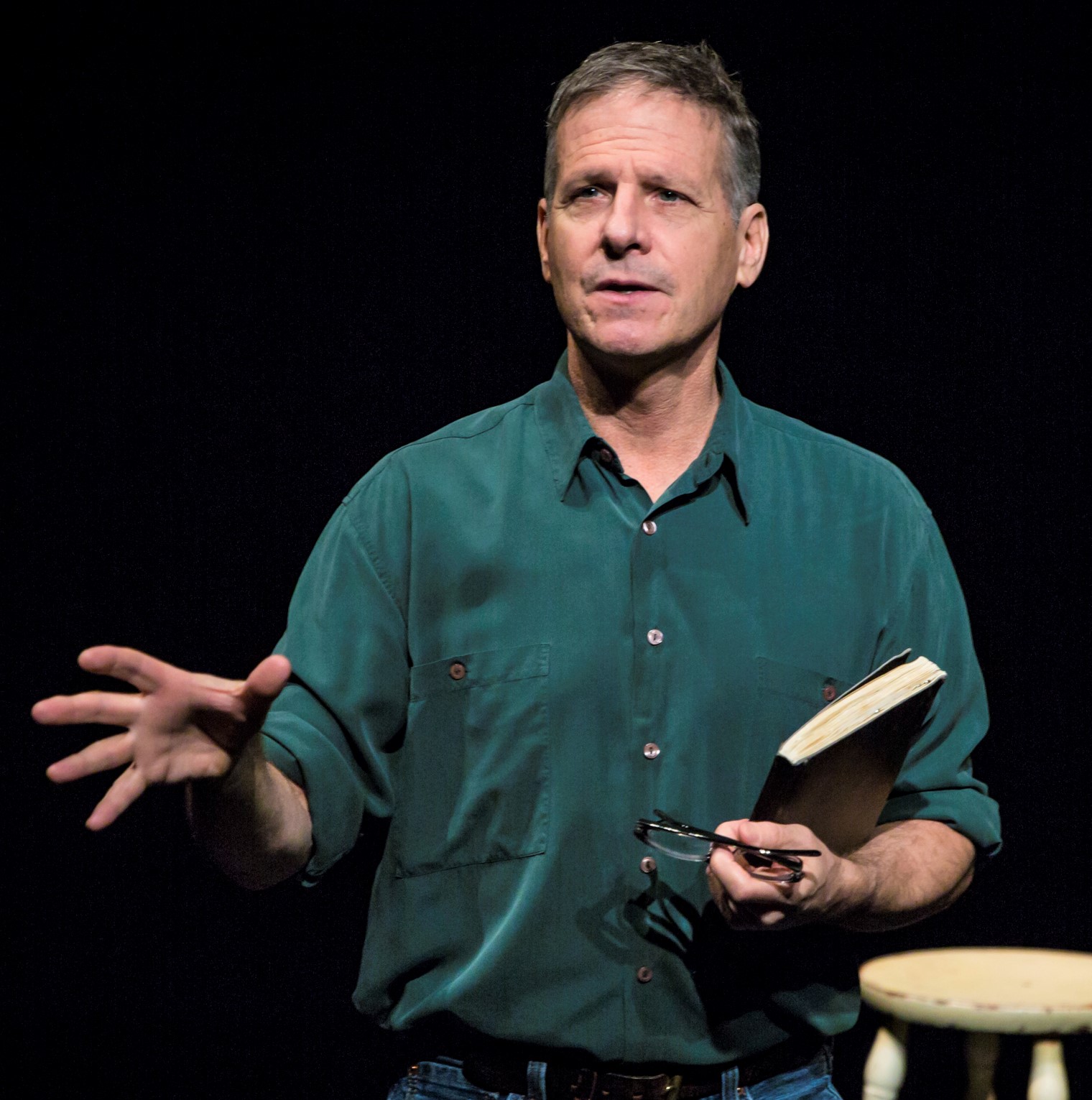Almost 15 years have passed since Martin Moran’s The Tricky Part premiered Off-Broadway. In 2004, stories of authority figures preying on children, though in the news, were not the media commonplace they’ve become. This solo drama about the author’s sexual relationship with an adult counselor from a Roman Catholic boys’ camp was an eye-opening tale of childhood trauma and its myriad aftereffects. Back then Moran’s accomplished performance of his own material, mixing pain and humor, registered as valiant self-exposure, affording audiences unprecedented insights about a stigmatized subject.
Martin Moran displays a photograph of himself at age 12 that was taken by camp counselor Bob. Top: Moran addresses the audience in the Barrow Group revival of The Tricky Part.
Over the past decade and a half, society has become increasingly conscious of predatory sexual behavior. It’s now accepted that this gruesome social phenomenon has always been more prevalent than acknowledged. The topic permeates media discourse, so it’s no wonder that the Barrow Group, the theater company with which Moran developed this play, is reviving it. But is it possible, after all that has been learned, for The Tricky Part to retain the supercharged impact it had in those less wised-up days when it premiered?
Honored with a special citation from the Obie committee and two Drama Desk nominations in the 2003–04 season, The Tricky Part chronicles Moran’s growing up middle-middle class and Catholic in suburban Denver. The academically gifted Marty (as he was called then) was the kind of charismatic kid who regularly lands leading roles in school plays. Seeing the onstage photograph of the 12-year-old, the audience can’t miss how filled with promise this lad must have been in 1972 when counselor Bob—30-ish, likable, and a consummate manipulator—asserted himself as mentor and seducer. (The photograph of Marty, visible onstage throughout the performance, was taken by Bob at the start of their relationship.)
On an overnight camping trip, Bob—rumored to have been a seminarian—fondles the vulnerable Marty. Drawing the boy into his sleeping bag, Bob initiates three years of sexual dominance that are followed by years of residual influence. The barely pubescent Marty knows nothing of sex beyond an elliptical account in the Boy Scout handbook. He’s conscious of being attracted to men (a fact Bob must have sensed), and he’s simultaneously aroused and repelled by Bob’s adult body and his caresses.
The bond that develops between man and boy becomes an obsession for Marty, upsetting his emotional balance with a blend of guilt, shame, and fear. Tormented by suicidal thoughts throughout high school, Marty has close calls with pills and his father’s .22. In due course, his anxious, depressed adolescence is replaced by a depressed adulthood that’s haunted with recollections of Bob’s misconduct and marked by compulsive sexual behavior.
Moran at an exuberant moment in his autobiographical monodrama. Photographs by Edward T. Morris.
Seth Barrish, who directed the original, does the same for this production, showing the delicacy of a conductor interpreting a complex symphony transcribed for a single instrument. In the course of 90 minutes, Moran’s performance varies widely in tempi and dynamics, yet the momentum never lags.
Elizabeth Mak’s lighting, effective throughout, is crucial to the dramatic power of the sequence depicting Bob’s first sexual overture and Marty’s capitulation. This long, central scene would be raw and discomfiting under any circumstances, but Mak, by decreasing illumination gradually until nothing is visible except the actor’s face, lends it an unnerving sense of intimacy.
At 58, Moran still has sufficient boyish charm to be credible as he travels backward in time. His beautifully written script steers clear of self-pity, pop psychology, and agitprop, and dramatizes with exquisite simplicity a complex individual’s response to adversity. Since the original Off-Broadway engagement, Moran has performed this drama for runs of various lengths in London, San Francisco, Seattle, San Jose, Denver, Canada, India, and Poland. Yet his emotional interpretation of the script and all its characters is vivid, believable, and unremittingly forceful, as though he’s living these experiences for the first time.
What’s “trickiest” about Moran’s saga is that his relationship with Bob, both historically and even after the confrontation that provides the play’s climax, has positive as well as sinister aspects. “I want to disown it,” says the grown-up Martin, “but it flashes through me that with this guy I rafted a river, watched a calf being born, cleared a field, conquered a glacier, learned a heifer from a Holstein, a spruce from a cedar.” Bob did damage, yet Moran wouldn’t be the strong figure he is today, nor would his play have its distinctive moral voice, without the totality of his experiences.
The Tricky Part runs through Dec. 16 at The Barrow Group (312 W. 36th St.). Evening performances are at 7:30 p.m. Thursday to Monday; matinees are at 3 p.m. Dec. 8 and 16. For information and tickets, call (866) 811-4111 or visit barrowgroup.org.





